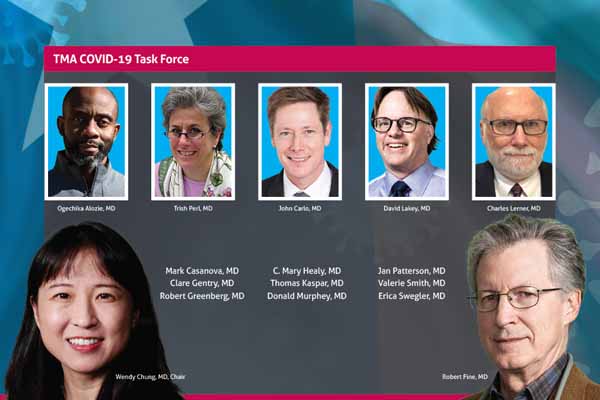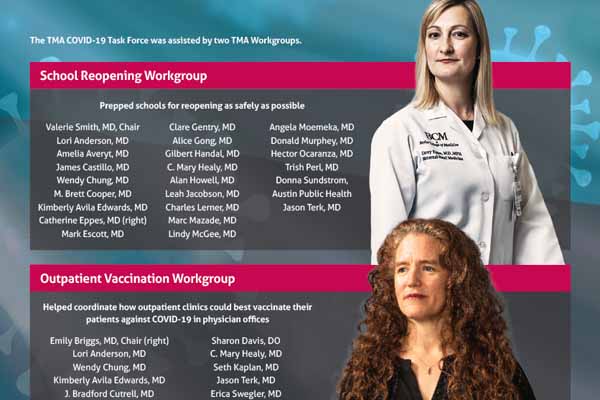
Like other members of the Texas Medical Association’s COVID-19 Task Force, public health expert John Carlo, MD, remembers the early days of the pandemic as a blur of activity.
“It’s interesting to try to relive all that even though it wasn’t that long ago,” the TMA board trustee and former medical director for Dallas County Health and Human Services said. “It was very tumultuous.”
As SARS-CoV-2, the virus that causes COVID-19, became widespread in March 2020, Americans witnessed public health measures that had not been widely used since the early 1900s, when infectious diseases like polio and Spanish flu prowled the landscape. Almost every type of in-person gathering stopped. Physician offices, workplaces, schools, travel destinations, stores, sports leagues, graduation ceremonies, and movie theaters all shut down.
Patients naturally had questions for physicians about the novel disease and how to react to it, but most physicians had no good answers themselves.
TMA moved to fill that void by forming the COVID-19 Task Force, a 15-member body made up of physician leaders of various specialties who could help physicians and their patients sift fact from fiction about the pandemic, says David Lakey, MD. He is an infectious disease expert who is vice chancellor for health affairs and chief medical officer at The University of Texas System.
“This group was to convene the physicians of TMA to have an ongoing conversation about what the science was telling us, what it wasn’t telling us, what new interventions were becoming available, how we were going to provide that information to the physicians, and how we were going to do risk communication tools to physicians so that they could educate their patients,” said Dr. Lakey, a former commissioner of the Texas Department of State Health Services. “It was a very physician-centric education group in the midst of a very rapidly changing environment.”
The COVID-19 Task Force sunsetted out of existence in May, not because COVID has gone away but because the disease is now a part of the medical landscape, and there are vaccines, medicines, and widespread medical know-how for treating it, Dr. Lakey says.
TMA had coordinated help for physicians and patients in previous epidemics and disease scares, but there was no precedent for setting up such a task force, says then-TMA President David C. Fleeger, MD, an Austin colon and rectal surgeon.
“It was unique, but it was also us once again reaching out to the membership to help us solve a problem,” said Dr. Fleeger, who appointed task force members. “And they did a great job.”
Though it has sunsetted, the COVID-19 Task Force provides TMA a template for how to handle future public health emergencies, Dr. Fleeger says.
“We will continue to call on … members for their expertise as our patients and our doctors face new challenges,” he said.
In 2020, the COVID-19 Task Force met weekly – on Zoom, of course – to discuss the pandemic’s latest developments, the best ways for Texas physicians to handle them, and the best ways to communicate that advice to physicians and patients.
“There were so many unknowns and unpredictable ways this pandemic evolved,” said Dallas infectious disease specialist Wendy Chung, MD, chair of the task force. “This task force contributed important work in building the plane while it was flying.”
Some of those topics seem quaint in retrospect, such as whether people should wipe down groceries to avoid transmission, says Dr. Carlo. But then, that was a big part of the problem – COVID-19 presented a wide array of problems and a lot of uncertainty.
“We were really trying to take on a lot of different things with limited evidence and information,” he said.
The task force members – chosen from different specialties, practice settings, and geographic locations – gave each other a view of the pandemic they otherwise would not have had, says Dallas infectious disease specialist Trish Perl, MD. Some pandemic-related topics were too big for the task force to handle alone, so TMA formed ad hoc workgroups of physicians from the task force and others as well.
While task force and workgroup members had no shortage of opinions, they treated each other with great respect, Dr. Perl says.
“For me, it helped me form a community, and that may not have been the goal of TMA, but it certainly was one of the things that was very rewarding to me,” she said. The task force “provided perspective that I may not have had without that group.”
One of the biggest issues early in the pandemic was letting people know how to interact safely with strangers. In July 2020, the task force put together a Know Your Risk During COVID-19 chart that ranked different activities like pumping gasoline, sitting in a doctor’s office, or going to a music concert according to their risk levels for spreading the illness. The chart was quickly reprinted on websites and news outlets worldwide.
“I thought that was one of the coolest things we did,” Dr. Perl said. “To me, it was really about communicating. And that’s what we talked about: How do we get out there, and how do we help physicians explain to patients what are the riskier activities, and put it in a way that is meaningful?”
Over time, and even to this day, task force members have become fixtures in Texas media outlets and found themselves fielding calls from international reporters.
“I put myself out here to help as much as I could,” said El Paso infectious disease specialist Ogechika Alozie, MD. “I’ve always enjoyed educating, and I’ve always enjoyed teaching, so this was nothing more than giving public health lectures once a week.”
But much of the time, the task force focused on the more mundane task of distilling the latest scientific information about topics like testing methods or monoclonal antibodies and relaying it to fellow physicians.
Many members sat not just on TMA’s task force but also on other COVID panels at both the state and local levels, Dr. Alozie says. That allowed them to more efficiently coordinate the medical response to the disease.
“It gives you a leverage point,” he said. “If you’re having contention at the local level [about a COVID-related matter], I could always turn back and say, ‘Here’s what TMA’s doing,’ or ‘We have a TMA meeting soon, and let me circle back and tell you what they say.’”
The meetings that took place in 2020 and 2021 often were followed by late-night phone calls among members trying to sort out a particularly thorny issue, says Christina Ly, TMA’s associate vice president for public health, who helped coordinate the efforts of the task force and these workgroups, along with Meredith Vinez, TMA senior public health policy analyst.

As the pandemic matured, the problems facing the task force became different but no less difficult. For instance, discussions about vaccines morphed from how to protect people’s health without vaccines to how to ethically distribute limited supplies of vaccines, and then on to how to get as many people as possible vaccinated.
One of the biggest problems caused by COVID-19 has been the tension between an “individual care ethic” and a “public health ethic,” says Dallas medical ethicist Robert Fine, MD.
“Normally, American medicine is based around the autonomy of the individual patient,” said Dr. Fine, clinical director of clinical ethics and palliative care at Baylor Scott and White Health. “We don’t worry too much about the impact of one person’s health care decisions on somebody else.”
But fighting a highly infectious respiratory disease led to public health measures like widespread vaccination, closing schools, and encouraging the use of masks, he says. That spurred a number of contentious political debates nationwide.
Members of the task force never let those debates interfere with their collegiality, Dr. Alozie says.
“It’s remarkable, given the political environment,” he said. “The task force was very uncontentious. Everybody was focused on the public good.”
However, members of the public often made their objections known in personal ways, says Dallas medical ethicist and palliative care specialist Mark Casanova, MD. He and other members had to fend off hostile calls, texts, emails, and social media from the public, and some even received threats to their safety.
“You’re really doing these things to save lives and mitigate suffering, and somebody posts on these doctor review sites that you’re [Nazi war criminal] Dr. Mengele and out to kill people, and it’s like, wow,” he said. “That made it tough.”
The COVID-19 Task Force’s work to help physicians through the emergency is done, but physicians still grapple with the legacies of the pandemic, like long COVID, Dr. Perl says. Many also deal with difficult memories, such as ambulances lined up outside hospitals because no more patients could be admitted. All of these problems undoubtedly will contribute to medical workforce difficulties in the future.
There are two major issues, she says.
“One is what people are calling burnout,” she said. Physicians “are just leaving jobs and going into different areas, moving to different settings, rethinking the hours that they’re going to work.”
The other is the frustration physicians face in finding ways to convince people about the ongoing danger of COVID-19.
“It’s the patient who tells you they don’t have COVID when you’re trying to put a tube down their throat … so they can breathe, and you’re putting yourself at risk, and they don’t want to have anything to do with it,” Dr. Perl said.
Studying COVID-19’s impact remains important because another pandemic or big public health emergency is inevitable, Dr. Casanova says. People looking back at the task force’s work may second-guess some of its decisions. But that will be less useful than understanding the context in which the decisions were made.
“As we go through the process of recalling, recollecting, reconciliation, and recovering, it’s important to remind ourselves that, hey, if we [want to] make calls on these things now, you have to ask, what was the situation at the time?” he said.
Most importantly, the task force provided an authoritative voice about the current state of science on COVID-19 when it was needed most, Dr. Lakey says.
“There are always things you can do differently, but the group was good and gave good advice,” he said. “The important thing was coming to a consensus on major recommendations … for the physicians and the people we served.”